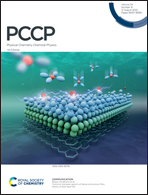Discrimination of enantiomers for chiral molecules using analytically designed microwave pulses
Abstract
We perform a theoretical exploration of quantum coherent control of enantio-selective state transfer (ESST) of chiral molecules with three rotational states connected by the a-type, b-type, and c-type components of the transition dipole moments. A pulse-area theorem based on a closed-loop three-level system is derived without applying the rotating-wave approximation and used to analytically design three linearly polarized microwave pulses with optimal amplitudes and phases. By utilizing two optimized microwaves to mix two excited rotational states into the maximal coherence, we find that the discrimination of enantiomers via ESST for chiral molecules can be achieved by controlling the delay time of the third optimized microwave pulse. We examine the robustness of such control schemes against the Rabi frequency and detuning errors and the environment effect through pure dephasing processes for practical applications. This work provides an alternative approach to analytically designing optimal control fields for quantum control of ESST by using complex pulse areas.



 Please wait while we load your content...
Please wait while we load your content...